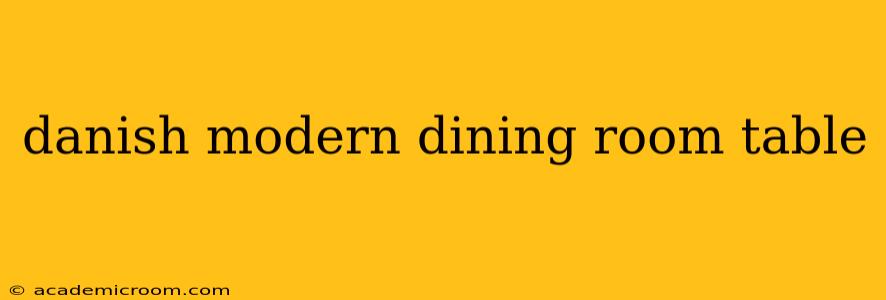The allure of a Danish Modern dining room table is undeniable. Its clean lines, organic forms, and emphasis on functionality resonate with today's modern aesthetic as much as they did in mid-century Denmark. But what exactly defines a Danish Modern dining table, and how can you choose the perfect one for your home? This comprehensive guide will explore everything you need to know about these iconic pieces of furniture.
What Defines a Danish Modern Dining Room Table?
Danish Modern design, flourishing in the 1950s and 60s, emphasized simplicity, functionality, and natural materials. This translates to dining tables characterized by:
- Simple, streamlined silhouettes: Avoidance of excessive ornamentation or fussy details. Think clean lines, tapered legs, and minimalist designs.
- Organic shapes: Often featuring rounded corners and gently curving edges, reflecting a connection to nature.
- High-quality natural materials: Wood is king, particularly teak, oak, and rosewood, chosen for their beauty and durability. Other materials like leather and wool might be incorporated in accompanying chairs.
- Functionality: Tables are designed to be both aesthetically pleasing and practical for everyday use. Many feature expandable leaves for accommodating larger gatherings.
- Craftsmanship: A hallmark of Danish Modern is the exceptional quality of craftsmanship. The joinery and finishing are typically meticulous.
What are the Most Common Materials Used in Danish Modern Dining Tables?
Wood: Teak, oak, and rosewood are the most commonly used woods, prized for their rich tones, durability, and beautiful grain patterns. Each wood offers a slightly different aesthetic:
- Teak: Known for its golden-brown hues and resistance to rot and insects.
- Oak: A lighter, more versatile wood with a range of tones from pale blonde to rich brown.
- Rosewood: Features a deep, reddish-brown color with striking grain patterns.
How Do I Choose the Right Size Danish Modern Dining Room Table?
Choosing the right size is crucial for both functionality and aesthetics. Consider:
- The size of your dining room: Ensure the table leaves enough space for comfortable movement around it.
- The number of people you typically dine with: Allow ample space per person (generally 24-30 inches).
- Expandable leaves: If you frequently entertain, an expandable table is a valuable investment.
How Do I Care for My Danish Modern Dining Table?
Proper care will preserve the beauty and longevity of your Danish Modern table:
- Regular dusting: Use a soft, dry cloth to remove dust regularly.
- Avoid harsh chemicals: Use mild soap and water for cleaning, avoiding abrasive cleaners or solvents.
- Use coasters and placemats: Protect the surface from scratches and spills.
- Apply furniture polish (sparingly): Use a high-quality furniture polish specifically designed for wood, applying it sparingly and buffing it to a shine.
What are Some Popular Danish Modern Dining Table Styles?
Danish Modern encompasses a range of styles, from minimalist to more expressive designs. Some popular variations include:
- Pedestal tables: Feature a single central pedestal base, maximizing legroom.
- Extendable tables: Offer versatility for both everyday use and larger gatherings.
- Tables with tapered legs: A classic feature of Danish Modern, adding a touch of elegance.
Where Can I Find Authentic Danish Modern Dining Tables?
Authentic mid-century pieces can be found at antique shops, flea markets, and online auction sites like eBay. Reputable furniture stores also often offer contemporary interpretations that capture the spirit of the original designs. Be sure to carefully examine any potential purchase for signs of damage or repair before committing to a purchase.
Are Danish Modern Dining Tables a Good Investment?
Yes, high-quality Danish Modern dining tables can be a sound investment. Their timeless design and durable construction mean they can last for generations, increasing in value over time, particularly for genuine vintage pieces.
How do I distinguish authentic Danish Modern from reproductions?
Authenticity is crucial when investing in Danish Modern furniture. Look for hallmarks such as maker's marks, specific wood types, and construction techniques characteristic of the era. Researching specific designers and manufacturers can also help you verify authenticity.
This guide provides a starting point for your exploration of Danish Modern dining room tables. With their enduring style and quality, these tables are a beautiful addition to any home. Remember to take your time, research your options, and select a table that reflects your personal taste and lifestyle.
